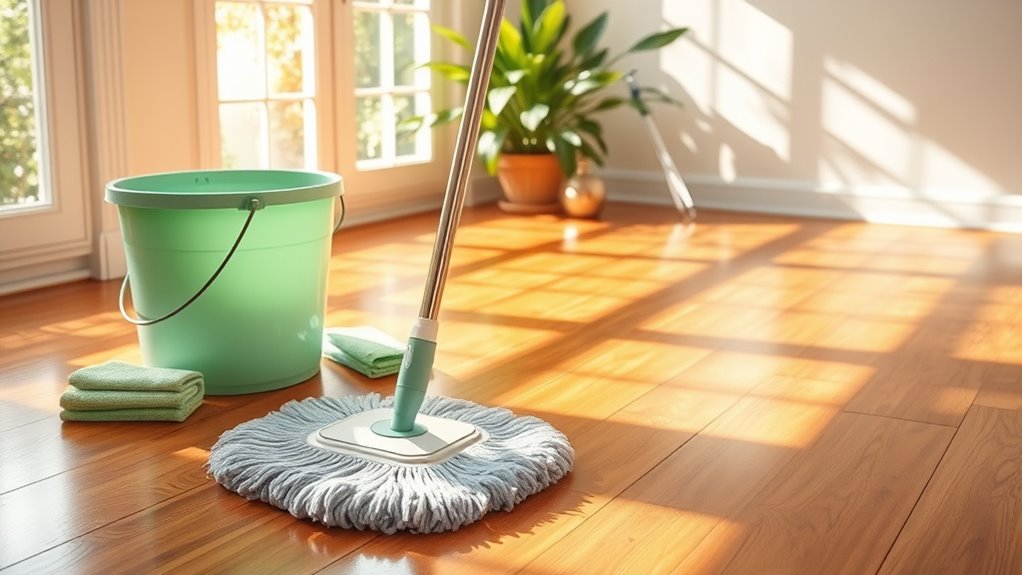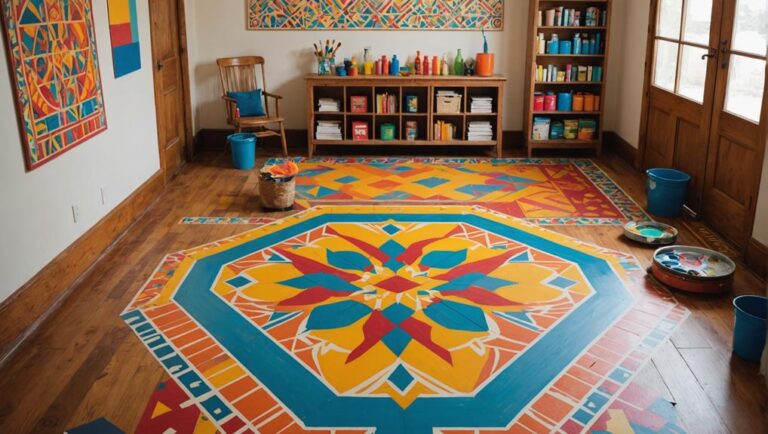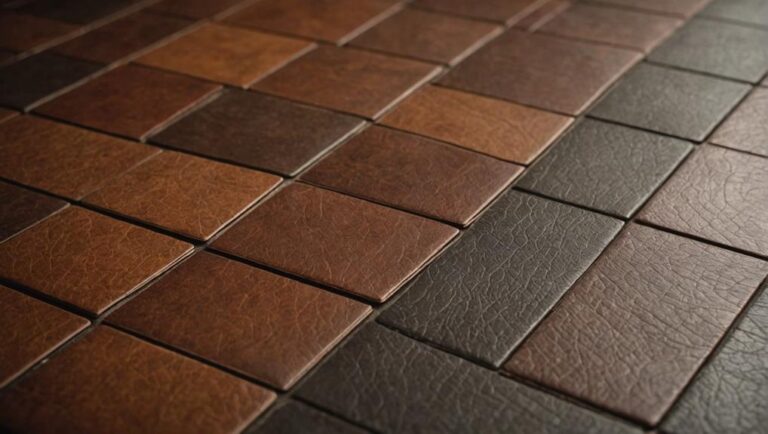To clean fake hardwood floors in seven easy steps, start by gathering soft-bristle broom, microfiber mop, and a gentle cleaner. Remove loose dirt by sweeping or vacuuming thoroughly, especially around edges. Mop with a damp cloth using streak-free strokes, avoiding excessive water. For stubborn stains, apply a mild cleaner and gently scrub. Dry the floor promptly to prevent damage, then maintain regular cleaning habits twice weekly. Following these precise steps guarantees lasting floor beauty, and you can explore more detailed tips as you go.
Gather the Necessary Cleaning Supplies
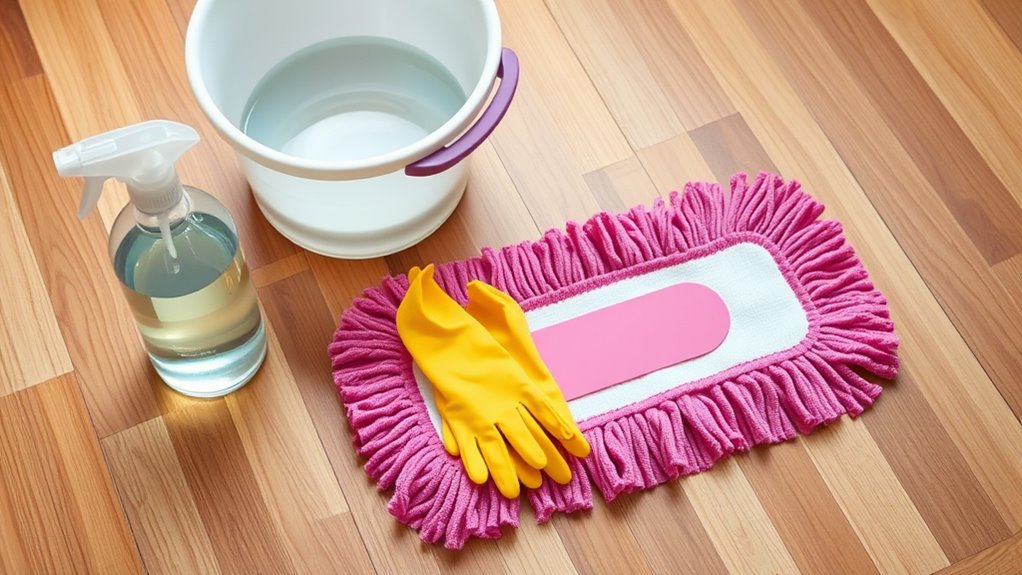
Before you begin cleaning your fake hardwood floors, it’s important to gather all the necessary supplies to guarantee an efficient process. Start with essential cleaning tools: a soft-bristle broom or vacuum with a hardwood attachment to avoid scratches, a microfiber mop, and a bucket for water and cleaning solution. Choose a gentle, pH-neutral cleaner specifically designed for laminate or vinyl floors to prevent damage. Avoid harsh chemicals that can strip the finish. Additionally, keep a few microfiber cloths handy for spot cleaning and drying. Incorporating these maintenance tips guarantees your floors stay pristine without unnecessary wear. Having the right supplies ready allows you to clean methodically and freely, maintaining your floors’ appearance while enjoying the ease and freedom of a straightforward cleaning routine.
Remove Loose Dirt and Debris
Start by sweeping your fake hardwood floors with a soft broom to gather loose dirt without scratching the surface. Follow up by vacuuming using a floor attachment to remove debris from hard-to-reach areas. Finally, use a dust mop to clean corners and edges where dirt tends to accumulate.
Sweep With Soft Broom
Although it might seem simple, sweeping your fake hardwood floors with a soft broom is essential to remove loose dirt and debris effectively. Choose a broom with soft bristle fibers to avoid scratching or damaging the surface. Start at one corner of the room and use smooth, deliberate strokes to gather dust and particles without scattering them. Apply a gentle touch—pressing too hard can harm the finish or push dirt into crevices. Focus on edges and corners where debris tends to accumulate. Sweep methodically, moving debris toward a central spot for easy collection. By regularly using a soft broom with care, you maintain your floor’s appearance and prevent buildup that can cause wear. This simple step gives you freedom from dirt while preserving your floor’s integrity.
Vacuum With Floor Attachment
After sweeping with a soft broom, using a vacuum with a floor attachment helps remove any remaining loose dirt and debris that may be missed. Floor attachments are specifically designed to clean hard surfaces gently without scratching, making them ideal for fake hardwood floors. The vacuum benefits include efficient dirt removal from crevices and uneven surfaces, which sweeping alone can’t achieve. When you use the right floor attachment, you protect your floor’s finish while ensuring thorough cleaning. Move the vacuum slowly and methodically across the floor to capture fine dust and particles. This step helps maintain the floor’s appearance and extends its lifespan by preventing buildup. Incorporating this vacuuming stage into your routine gives you freedom from stubborn dirt and keeps your fake hardwood floors looking fresh.
Dust Mop for Corners
To effectively remove loose dirt and debris from corners, use a dust mop designed to reach tight spaces. Corner dusting requires tools that can access narrow areas where dirt tends to accumulate. Choose a dust mop with a slim, angled head or flexible edges to glide along baseboards and into crevices. Pair this with microfiber pads, which trap dust without scattering it. When dust mopping, move slowly and methodically, ensuring you cover every inch of the corner. Regular corner dusting prevents buildup, maintaining the floor’s appearance and extending its lifespan. Incorporate this step into your routine cleaning process using proper cleaning tools that make the task easier and more efficient. This focused approach keeps your fake hardwood floors looking fresh and debris-free.
Sweep or Vacuum the Floor Thoroughly
Start by thoroughly sweeping or vacuuming your fake hardwood floors to remove dust, dirt, and debris that can scratch the surface during cleaning. Proper floor cleaning starts with this essential step to protect your flooring and guarantee effective results. Use these cleaning techniques:
- Choose a soft-bristle broom or a vacuum with a hardwood floor setting to avoid damage.
- Sweep or vacuum in the direction of the floor planks to capture particles between grooves.
- Pay special attention to high-traffic areas and corners where debris accumulates.
- Empty the vacuum or dustpan frequently to maintain suction and prevent redistribution of dirt.
Mop Using a Damp Cloth or Mop
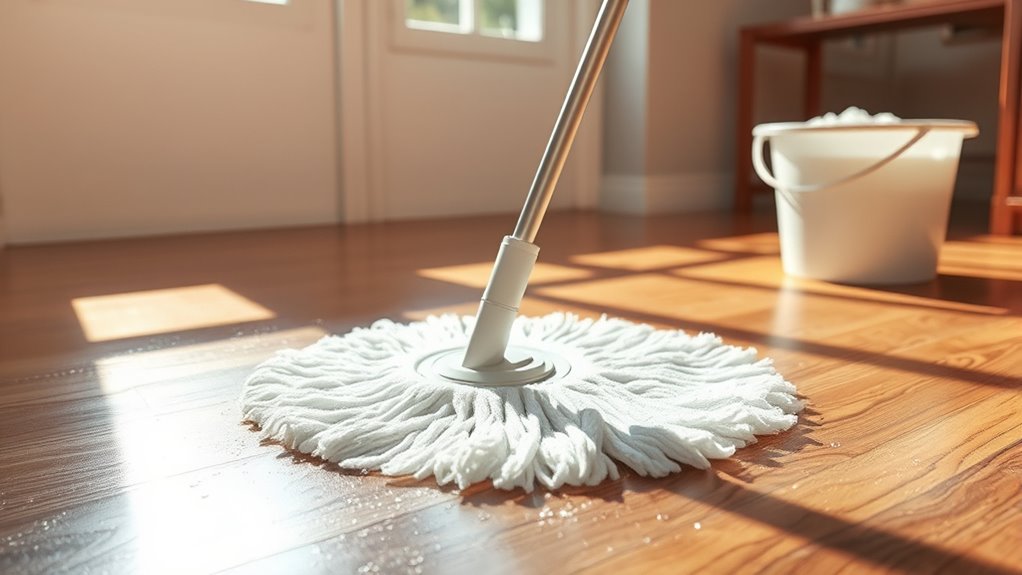
You’ll want to select a mop with a soft, non-abrasive cloth to protect your floor’s surface. Make sure the mop is only damp, not wet, to prevent water damage. Use gentle, even strokes to clean without causing scratches or warping.
Choose Appropriate Mop Type
Selecting the right mop is essential for maintaining the appearance and integrity of fake hardwood floors. You want to choose mop materials and mop techniques that protect the floor while effectively cleaning it. Here’s how to pick the best mop type:
- Microfiber mops – Ideal for trapping dust and dirt without scratching surfaces.
- Sponge mops – Absorbent and easy to wring but can hold excess water if not properly maintained.
- Flat mops – Lightweight and maneuverable, perfect for routine cleaning.
- Steam mops – Generally not recommended as excessive moisture can damage fake hardwood floors.
Optimal Dampness Level
One key factor when mopping fake hardwood floors is maintaining the right level of dampness to avoid damage. You want to achieve a proper moisture balance; too much water can seep into seams and cause warping, while too little won’t clean effectively. Adjust your cleaning frequency based on wear, but each time, wring your mop or cloth thoroughly so it’s only damp, not wet.
| Moisture Level | Effect |
|---|---|
| Too Wet | Risk of swelling, warping |
| Slightly Damp | Ideal moisture balance |
| Dry | Ineffective cleaning |
| Frequently Cleaned | Maintains floor’s appearance |
Mop in Gentle Strokes
Move your mop or cloth with gentle, deliberate strokes to protect your fake hardwood floors from scratches and damage. Selecting the right mop types and mastering cleaning techniques guarantees both cleanliness and floor longevity. Here’s how to mop effectively:
- Choose a microfiber mop or soft cloth to avoid abrasions.
- Dampen the mop just enough—excess water can harm the floor.
- Mop in straight lines, overlapping slightly to cover all areas.
- Avoid harsh scrubbing; let the mop glide smoothly to lift dirt.
Address Stubborn Stains With Mild Cleaner
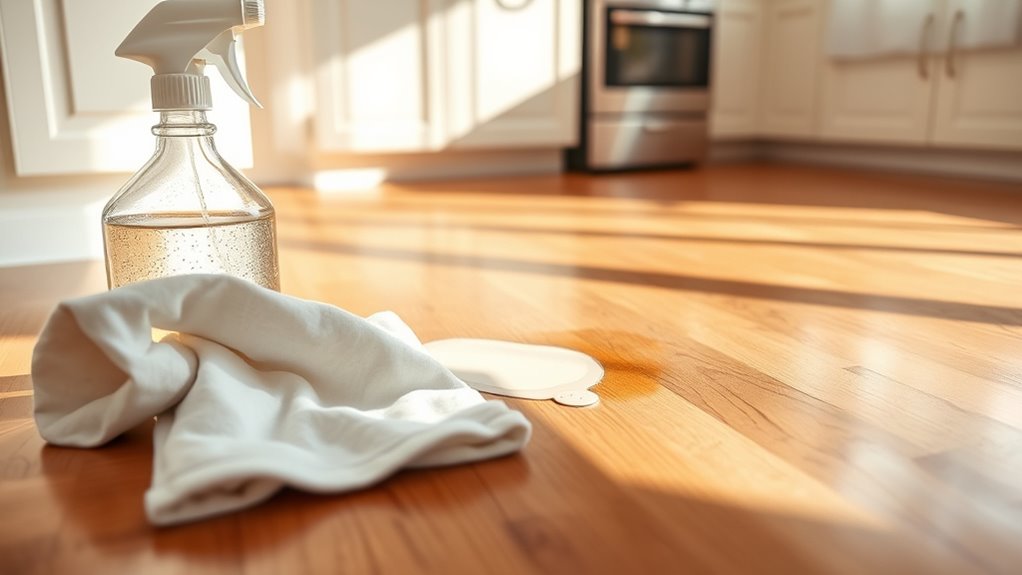
Although fake hardwood floors are durable, stubborn stains can still occur and require careful attention. To tackle these, start by selecting mild cleaners specifically designed for laminate or vinyl surfaces. Avoid harsh chemicals that might damage the floor’s finish. Apply a small amount of the mild cleaner directly to the stained area. Use a soft cloth or sponge to gently rub the stain in a circular motion, allowing the cleaner to break down the residue without spreading it. For tougher spots, let the cleaner sit for a minute before wiping. Always test the cleaner on an inconspicuous area first to guarantee it won’t discolor or harm the floor. This methodical approach guarantees effective stain removal while preserving your floor’s appearance and your freedom from harsh treatments.
Dry the Floor to Prevent Water Damage
After treating stubborn stains with a mild cleaner, it’s important to dry the floor thoroughly to prevent water damage. Proper floor drying not only preserves the look of your fake hardwood but also extends its lifespan. Here’s how to do it efficiently:
- Use a clean, dry microfiber cloth or mop to absorb excess moisture.
- Open windows or turn on fans to increase air circulation, speeding up evaporation.
- Avoid walking on the floor until it’s completely dry to prevent smudges or dirt marks.
- Check corners and edges carefully, as water can accumulate there and cause damage over time.
Maintain Regular Cleaning Habits
Regularly cleaning your fake hardwood floors is essential to maintain their appearance and durability. To keep them looking their best, establish a consistent cleaning frequency that suits your lifestyle—typically, sweeping or vacuuming twice a week works well to remove dust and debris. Develop a maintenance schedule that includes mopping with a damp cloth or a recommended cleaner once every one to two weeks, depending on foot traffic. Sticking to this routine prevents buildup that can dull the surface or cause damage over time. By committing to these regular habits, you’ll protect your floors while enjoying the freedom to live without constant worry about wear. Consistency is key—set reminders if needed to guarantee your floors stay clean and well-maintained effortlessly.

